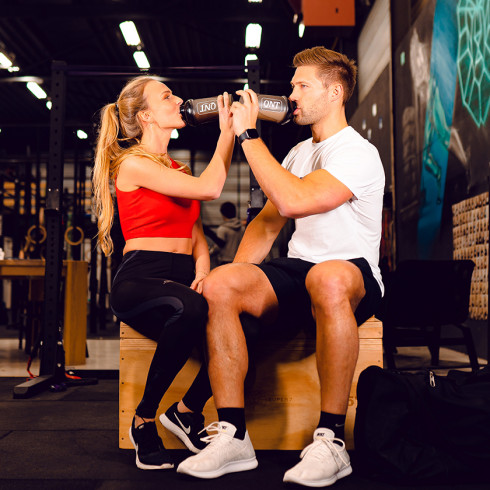How to lose weight after 30?
TABLE OF CONTENTS
- Metabolism and Age: After 30, metabolism starts to slow down, which can make weight loss more challenging.
- What is the best diet for losing weight after 30?
- What exercises are most effective for losing weight after 30?
- What supplements can help with weight loss after 30?
- What mistakes should be avoided when trying to lose weight after 30?
- What muscular qualities can still improve after 30?
- Coach's Tips
METABOLISM AND AGE: AFTER 30, METABOLISM BEGINS TO SLOW DOWN, WHICH CAN MAKE WEIGHT LOSS MORE DIFFICULT.
Metabolism is the set of biochemical processes that allow our body to convert food into energy and ensure vital functions such as breathing, digestion, and regulating body temperature. After 30, it is common to observe a slowdown in this process, which can make weight management more challenging. This phenomenon is related to several factors:
1. Decrease in muscle mass.
From the age of thirty, muscle mass tends to gradually decrease, a phenomenon known as sarcopenia. Since muscle is more metabolically active than fat, a decrease in muscle mass reduces the body's energy requirements. As a result, the basal metabolism (the amount of calories burned at rest) decreases, which can lead to weight gain if food intake remains the same.
2. Hormonal fluctuations.
In both men and women, hormonal changes can affect metabolism. In women, the gradual decline in estrogen levels after 30 influences fat distribution, often leading to more fat storage around the abdomen. In men, a decrease in testosterone can also reduce muscle mass and, consequently, slow down metabolism.
3. Reduction in physical activity.
As we age, professional and family responsibilities often increase, leaving less time for regular physical activity. Less exercise means fewer calories burned, and without dietary adjustments, this can lead to weight gain. The lack of exercise also contributes to muscle mass loss, further exacerbating the decrease in metabolism.
4. Energy adaptations.
With age, the body becomes more efficient at using energy. This means it burns fewer calories to perform the same activities as it did at 20 or 25 years old. This process of energy adaptation, if not compensated by adjustments in dietary habits and regular exercise, makes weight loss more difficult.
How to address it?
Fortunately, there are solutions to counter this metabolic slowdown after 30:
- Strength training exercises: Increasing muscle mass through weight training or other forms of resistance exercises can help maintain a high metabolism.
- Regular physical activity: Cardio, high-intensity interval training (HIIT), and daily walking are essential for maintaining a good energy expenditure.
- Balanced diet: Adopting a diet rich in protein to support muscle mass and adjusting calorie intake according to individual needs. Fiber-rich foods, lean proteins, and healthy fats can help stabilize metabolism.
- Adequate hydration: Drinking enough water helps the metabolism function optimally.
Adopting these strategies not only compensates for the effects of metabolic slowdown but also promotes weight loss and the maintenance of a healthy body composition after 30.
5. Stress and Sleep Management: Impact on Metabolism and Weight Gain.
Stress and sleep play a major role in weight management, especially after 30, as they directly influence metabolism and eating behaviors.
1. Stress and Cortisol
When we are stressed, our body releases a hormone called cortisol. While this hormone is necessary to cope with stressful situations, chronic cortisol production can have negative effects on metabolism. Indeed, high levels of cortisol increase appetite, promote fat storage (particularly around the abdomen), and reduce the body's ability to burn calories efficiently. Stress can also lead to emotional eating habits, where people turn to high-calorie foods for comfort.
2. Sleep and Hormonal Regulation
Lack of sleep or poor-quality sleep can also slow down metabolism. Sleeping less than 7-8 hours per night disrupts the hormones that regulate hunger, particularly leptin and ghrelin. Leptin, which signals satiety, decreases, while ghrelin, which stimulates appetite, increases. This can lead to overeating and, in the long term, weight gain. Poor sleep quality also reduces motivation to exercise and slows muscle recovery.
6. Maintaining Motivation and Consistency: Sustainable Habits for Long-Term Weight Loss.
One of the biggest challenges after 30 is maintaining motivation and adopting sustainable habits for long-term weight loss. Here are some tips to help you achieve this:
1. Set realistic goals
It is crucial to set goals that are both achievable and measurable. Drastic changes or overly restrictive diets can lead to quick burnout and demotivation. The key is to implement gradual changes that are sustainable, like incorporating more protein into each meal or adding a few extra workout sessions each week.
2. Surround yourself with support
Working with a coach, joining a fitness community, or involving friends and family in your journey can help maintain motivation. Constant support helps overcome difficult moments and keeps you focused on long-term goals.
3. Celebrate small victories
It's important to acknowledge and celebrate each milestone, even if it seems small. This helps you stay motivated and recognize that even minimal efforts produce positive results over time.
7. Medical Monitoring and Personalized Diets: Importance of Professional Guidance.
After 30, metabolism, nutritional needs, and response to training can vary from person to person. This is why regular monitoring by a doctor or health professional is essential for adjusting weight loss strategies.
1. Personalized Medical Monitoring
Nutritional needs and physical abilities change with age. Medical monitoring helps adjust nutrient intake, especially to avoid vitamin or mineral deficiencies that can slow down metabolism. Additionally, some age-related medical conditions, such as thyroid or hormonal issues, can influence weight loss. Regular check-ups help identify and address these potential problems before they become major obstacles.
2. Personalized Diets
Each individual reacts differently to diets and workout plans. A dietitian or nutritionist can help create a tailored meal plan, taking into account individual metabolism, physical activity level, and personal preferences. It's about adopting a customized approach to maximize weight loss while ensuring optimal health.
3. Adapting Workout Routines
After 30, recovery abilities can decrease, making it crucial to adjust workout routines according to specific needs. A program that accounts for rest periods, muscle recovery, and incorporates appropriate strength training exercises allows for maintaining an effective level of physical activity without risking injury.
Stress and sleep management, consistency in effort, and regular medical monitoring are essential elements for maintaining a healthy metabolism and optimizing weight loss after 30. By implementing sustainable strategies and personalizing the approach, it is possible to overcome age-related challenges and continue achieving fitness goals.
WHAT IS THE BEST DIET FOR LOSING WEIGHT AFTER 30?
Après 30 ans, la gestion du poids devient plus complexe en raison des changements métaboliques, hormonaux et du mode de vie. Le meilleur régime alimentaire pour perdre du poids à cet âge doit être adapté à ces évolutions tout en étant sain, durable et équilibré. Voici quelques principes clés pour un régime efficace après 30 ans.
1. Adopt a protein-rich diet.
Proteins play a crucial role in weight loss after 30. They help preserve and increase muscle mass, which is particularly important as muscle mass tends to decrease with age. A greater proportion of muscle helps maintain a high metabolism and burn more calories, even at rest.
Preferred sources of protein include:
- Lean proteins: chicken, turkey, fish.
- Plant-based proteins: lentils, chickpeas, beans.
- Dairy products: Greek yogurt, cottage cheese.
- Protein supplements: whey, protein isolate, these provide an easy intake of high-quality protein.
2. Reduce the consumption of refined carbohydrates.
Refined carbohydrates, such as white bread, pastries, and sugary products, are often low in fiber and nutrients while being high in calories. They cause rapid blood sugar spikes followed by sudden energy crashes, which stimulate appetite and promote fat storage, especially around the abdomen.
It is recommended to prioritize complex carbohydrates that are high in fiber, as they help maintain a longer feeling of fullness and stabilize blood sugar levels. Good sources of complex carbohydrates include:
- Whole grains: quinoa, brown rice, oats.
- Vegetables: sweet potato, squash.
- Legumes: lentils, black beans.
3. Increase fiber intake.
Dietary fiber is essential for digestion and provides a lasting feeling of fullness. It also helps regulate blood sugar levels, which helps prevent cravings. A high-fiber diet is associated with a reduced risk of overweight and obesity.
Foods rich in fiber include:
- Green vegetables: spinach, broccoli, Brussels sprouts.
- Fresh fruits: apples, berries, pears.
- Legumes: chickpeas, lentils.
- Seeds and nuts: chia seeds, flax seeds, almonds.
4. Incorporate healthy fats.
Fats play a key role in hormonal regulation and help maintain a healthy metabolism. Contrary to popular belief, healthy fats should not be eliminated. They help you feel fuller for longer and support cellular function. However, moderation is key, and it is important to choose high-quality fat sources.
Good sources of healthy fats include: Avocado.
- Vegetable oils: olive oil, flaxseed oil.
- Nuts and seeds: almonds, cashews, chia seeds.
- Fatty fish: salmon, mackerel, sardines.
5. Control portions and avoid calorie excess.
After 30, metabolism gradually slows down, meaning the body needs fewer calories to maintain its weight. It is therefore important to control portions and avoid consuming more calories than necessary. Eating slowly and being mindful of satiety signals helps better control calorie intake and avoid overeating.
6. Drink enough water.
Dehydration can be mistaken for hunger, leading to unnecessary snacking. Additionally, proper hydration helps optimize metabolism and eliminate toxins. It is recommended to drink at least 1.5 to 2 liters of water per day, depending on physical activity.
7. Limit sugary drinks and alcohol.
Sugary drinks (sodas, industrial fruit juices) and alcohol contain many "empty" calories, meaning calories with no significant nutritional value. These drinks promote blood sugar spikes, increase appetite, and contribute to weight gain. It is better to replace them with water, unsweetened tea, or herbal infusions.
8. Consume anti-inflammatory foods.
After 30, the risk of chronic inflammation increases, which can hinder weight loss. Foods rich in antioxidants and omega-3s, such as berries, nuts, fatty fish, and leafy green vegetables, help reduce inflammation and support the weight loss process.
The best diet for losing weight after 30 is one that is not only rich in nutrients but also tailored to individual needs, balanced, and sustainable in the long term. By prioritizing proteins, fiber, healthy fats, and reducing refined carbohydrates and empty calories, it is possible to effectively support weight loss while promoting better overall health. The use of quality supplements, such as those offered by QNT, can also help maximize results by supplementing nutritional intake and supporting recovery after exercise.
WHAT EXERCISES ARE MOST EFFECTIVE FOR LOSING WEIGHT AFTER 30?
After 30, losing weight becomes more challenging due to the slowdown in metabolism and hormonal changes. However, with a tailored exercise program, it is entirely possible to boost fat burning, maintain muscle mass, and improve physical fitness. Here are the most effective types of exercises for losing weight at this age.
1. Resistance training (strength training).
Strength training is one of the most effective ways to lose weight after 30, as it helps build and maintain muscle mass. Since muscle is metabolically active, the more muscle you have, the more calories you burn, even at rest. This effect helps accelerate the basal metabolism, which is essential for countering the age-related metabolic slowdown.
Strength training exercises can include:
- Free weight exercises: squats, deadlifts, bench press, lunges.
- Dumbbell or kettlebell exercises: clean and press, kettlebell swings.
- Weight machines: leg machines, upper body pull machines.
By performing compound exercises (which engage multiple muscle groups at once), such as squats or deadlifts, you maximize calorie expenditure and strengthen the entire body.
2. High-Intensity Interval Training (HIIT).
HIIT (High-Intensity Interval Training) is extremely effective for burning calories and improving fitness in a short amount of time. This type of training involves alternating periods of intense effort with periods of active recovery or rest. HIIT has the advantage of keeping the heart rate elevated, which boosts fat burning during the workout and for several hours afterward, thanks to the "afterburn" effect (EPOC or Excess Post-Exercise Oxygen Consumption).
An example of a HIIT session can include:
- Sprints: 30 seconds of sprinting, followed by 30 seconds of walking or resting.
- Bodyweight exercises: burpees, squat jumps, mountain climbers in intervals.
- Dynamic movement combinations: jumping jacks, jumping lunges, box jumps.
HIIT is ideal for people with a busy schedule, as it allows for a high calorie burn in a short period of time.
3. Regular cardio (aerobic).
Traditional cardio remains a proven way to lose weight, especially when practiced regularly and at a moderate to high intensity. Cardio exercises increase heart rate and promote fat burning, particularly when you stay in the optimal heart rate zone for weight loss (about 60-70% of maximum heart rate).
Here are some effective forms of cardio exercises:
- Running or jogging.
- Cycling (outdoor or stationary bike).
- Swimming.
- Rowing.
- Brisk walking: although less intense, brisk walking is an excellent option for beginners or those looking to complement other types of training.
Cardio, performed for at least 30 to 45 minutes several times a week, is effective for burning calories, but it is even more beneficial when combined with strength training.
4. Functional and bodyweight training.
Functional training, which uses natural body movements to improve strength and mobility, is also very effective for weight loss. This type of training strengthens muscles while improving coordination, balance, and flexibility.
Functional exercises include:
- Burpees.
- Bodyweight squats.
- Push-ups.
- Forward and lateral lunges.
- Planks and variations.
This type of training is particularly effective for people looking to improve their overall fitness while losing weight.
5. Sprint Interval Training (SIT).
Similar to HIIT, Sprint Interval Training (SIT) focuses on short periods of intense sprinting, followed by longer recovery periods. It is a highly effective method for increasing aerobic capacity and fat burning. A typical SIT session could include several sets of 20 to 30-second sprints, with 1 to 2 minutes of recovery between each sprint.
SIT is particularly useful for burning maximum calories in minimal time while improving explosive power.
6. Mobility and flexibility training.
Although mobility and flexibility do not directly contribute to weight loss, they play a crucial role in injury prevention and improving movement quality during exercise. Good mobility allows you to maintain a high training intensity, which is essential for burning calories effectively. Incorporating mobility exercises (such as dynamic stretching, yoga, or Pilates) can therefore support a weight loss program.
7. Combination of exercise types.
The ideal way to maximize weight loss is to combine several types of exercises, such as strength training, cardio, HIIT, and functional training. This helps vary the stimuli on the body, improve overall fitness, avoid monotony, and keep progressing.
Here is an example of an effective training week:
- Monday: Strength training (upper body).
- Tuesday: HIIT.
- Wednesday: Cardio (running or cycling).
- Thursday: Strength training (lower body).
- Friday: HIIT or SIT.
- Saturday: Functional training or cardio.
- Sunday: Yoga or mobility (active recovery day).
To lose weight effectively after 30, it is essential to combine strength training to maintain muscle mass, cardio sessions to burn calories, and high-intensity workouts to maximize energy expenditure. This combination of exercises, paired with a balanced diet and proper recovery, helps counter metabolic slowdown and optimize weight loss.
WHAT SUPPLEMENTS CAN HELP WITH WEIGHT LOSS AFTER 30?
After 30, the slowdown of metabolism, hormonal fluctuations, and a more sedentary lifestyle can make weight loss more challenging. Dietary supplements can be an effective support to maximize the efforts of a balanced diet and a tailored exercise program. Here are some supplements that can help boost weight loss after 30:
1. Protein powders.
Proteins are essential for maintaining and building muscle mass, which is crucial for keeping an active metabolism. After 30, muscle mass tends to gradually decrease, slowing down calorie expenditure. Protein supplements, such as whey or protein isolate, can help increase protein intake without consuming extra calories from other sources.
How they help:
- Increased satiety: Proteins increase the feeling of fullness, reducing cravings for snacks.
- Preservation of muscle mass: They help prevent muscle loss that often occurs with weight loss, allowing for the maintenance of an active metabolism.
2. Green tea and green tea extracts.
Green tea is rich in antioxidants called catechins, particularly EGCG (epigallocatechin gallate), which has been linked to increased fat burning. It also contains caffeine, which can help boost metabolism. The combination of EGCG and caffeine can increase calorie expenditure and promote weight loss.
How they help:
- Increase in thermogenesis: Green tea can increase heat production in the body, helping to burn more calories.
- Improved fat oxidation: Catechins can encourage the breakdown of stored fats in the body.
3. Dietary fibers.
Fiber supplements, such as psyllium or inulin, can be helpful for individuals who do not consume enough fiber through their diet. Fiber promotes satiety, helps regulate digestion, and controls blood sugar spikes, which can reduce food cravings.
How they help:
- Increased satiety: Fiber slows digestion, helping you feel full for longer.
- Blood sugar regulation: It prevents rapid spikes and drops in blood sugar levels, reducing sugar cravings.
4. Omega-3 fatty acids.
Omega-3 fatty acids, found in supplements like fish oil, have anti-inflammatory effects and can help regulate fat metabolism. They are also beneficial for cardiovascular health and cognitive function, two important aspects for maintaining overall health as you age.
How they help:
- Reduction of inflammation: Chronic inflammation can slow down weight loss, and omega-3s help reduce it.
- Improved insulin sensitivity: They help better manage blood sugar levels, which can limit fat storage.
5. Thermogenic fat burners.
Thermogenic fat burners are supplements that increase body temperature, thus stimulating metabolism and calorie burning. They often contain ingredients like caffeine, green tea, capsaicin (chili pepper extract), and other substances that boost energy expenditure.
How they help:
- Increase in calorie expenditure: Thermogenics help burn more calories, even at rest.
- Improved physical endurance: The stimulants in these supplements can boost energy and endurance, making it easier to perform longer and more intense workouts.
6. CLA (Conjugated Linoleic Acid).
CLA is a fatty acid naturally found in meat and dairy products. It is often taken as a supplement for its supposed effects on reducing body fat and improving body composition. CLA may promote fat loss while helping to preserve muscle mass.
How it helps:
- Improvement in body composition: CLA can promote a better balance between muscle mass and fat mass.
- Stimulation of lipolysis: It may encourage the breakdown of stored fats in the body.
7. L-carnitine.
L-carnitine is an amino acid that plays a key role in transporting fatty acids into cells to be used as an energy source. While the body naturally produces L-carnitine, a supplement can help enhance fat burning, especially during exercise.
How it helps:
- Improved fat oxidation: L-carnitine promotes the use of fat as an energy source, particularly during exercise.
- Increased endurance: It can help reduce fatigue during workouts, allowing for longer training sessions.
8. Vitamin D supplements.
Vitamin D is crucial for metabolism, insulin regulation, and maintaining bone and muscle health. A lack of vitamin D has been associated with weight gain and difficulties in losing weight, particularly in people over 30.
How it helps:
- Insulin regulation: Vitamin D helps stabilize blood sugar levels, which can reduce sugar cravings and limit fat storage.
- Improved muscle health: Better muscle health promotes a more active metabolism.
While supplements do not replace a balanced diet and regular exercise, they can be a valuable support for weight loss after 30. Supplements like protein powder, green tea, fiber, omega-3, and L-carnitine can help boost metabolism, improve fat burning, and promote better weight management.
WHAT MISTAKES SHOULD BE AVOIDED WHEN LOSING WEIGHT AFTER 30?
Weight loss after 30 can be more challenging due to physiological and hormonal changes, but certain common mistakes can further slow progress. Here are the main mistakes to avoid to optimize your weight loss after 30 and ensure lasting results.
1. Following overly restrictive diets.
Drastic or highly restrictive diets may seem effective in the short term, but they are not sustainable long-term and can even harm your metabolism. After 30, a diet that is too low in calories can lead to muscle mass loss, further slowing down metabolism. Additionally, overly restrictive diets can create nutritional deficiencies, weaken the immune system, and trigger cravings, often leading to a yo-yo effect.
How to avoid this mistake:
- Choose a balanced and moderate approach: Slightly reduce your calorie intake while ensuring a good balance of macronutrients (proteins, carbohydrates, fats) and making sure to provide all essential nutrients.
- Focus on quality over quantity: Concentrate on nutrient-dense foods rather than just counting calories.
2. Ignoring strength training.
A common mistake is to focus solely on cardio exercises for weight loss while neglecting strength training. After 30, it is crucial to preserve muscle mass, as it plays a key role in maintaining an active metabolism. By neglecting strength training, you risk losing not only fat but also muscle, which slows down calorie burning in the long term.
How to avoid this mistake:
- Incorporate regular strength training sessions into your workout program, targeting major muscle groups. This will help maintain or increase muscle mass, which is essential for supporting a healthy metabolism.
- Combine cardio and strength training to maximize results and ensure a more balanced weight loss.
3. Not getting enough sleep.
Lack of sleep is one of the major mistakes that can hinder weight loss. After 30, responsibilities often increase, which can lead to insufficient sleep. Poor quality or inadequate sleep disrupts the hormones that regulate hunger (such as leptin and ghrelin), which can trigger food cravings and overeating. Additionally, lack of sleep can increase cortisol levels, a hormone that promotes fat storage, particularly around the abdomen.
How to avoid this mistake:
- Get at least 7 to 8 hours of sleep per night to regulate hunger hormones and promote better recovery.
- Establish a regular sleep routine by avoiding screens before bedtime and creating a restful environment.
4. Underestimating the importance of protein.
After 30, it is essential to consume enough protein to maintain muscle mass and support weight loss. Many people make the mistake of underestimating the importance of protein in their diet, which can lead to muscle loss and a slowdown in metabolism. Proteins also play a key role in the feeling of fullness, helping to avoid cravings.
How to avoid this mistake:
- Increase your protein intake by consuming a variety of sources such as lean meat, fish, eggs, legumes, and dairy products. Protein supplements, like those from QNT, can also be a convenient way to meet your daily goals.
- Incorporate protein into every meal to stabilize blood sugar levels and improve satiety.
5. Skipping meals.
Some people believe that skipping meals can help reduce calorie intake and promote weight loss. However, this strategy can actually have the opposite effect, as it increases cravings and the risk of overeating at the next meal. Skipping meals also slows down metabolism, as the body enters "energy-saving" mode, making weight loss more difficult.
How to avoid this mistake:
- Eat at regular intervals, ideally every 3 to 4 hours, to keep your metabolism active and avoid snacking cravings.
- Focus on balanced meals that include protein, healthy fats, and complex carbohydrates for sustained energy.
6. Underestimating the importance of hydration.
Hydration plays a key role in weight loss, and many people neglect this aspect. Mild dehydration can be mistaken for hunger, leading to overeating when the body simply needs water. Additionally, proper hydration supports metabolism and helps eliminate toxins.
How to avoid this mistake:
- Drink at least 1.5 to 2 liters of water per day, or more if you are active.
- Replace sugary drinks with water, herbal teas, or unsweetened tea to reduce unnecessary calorie intake.
7. Not managing stress.
Chronic stress is a major enemy of weight loss. When stress levels are high, cortisol levels increase, which can stimulate appetite, trigger sugar cravings, and promote fat storage, particularly in the abdominal area. Additionally, unmanaged stress can lead to a lack of motivation to exercise or maintain a healthy diet.
How to avoid this mistake:
- Adopt stress management techniques such as meditation, yoga, or deep breathing to control your cortisol levels.
- Take time to relax regularly and avoid prolonged stressful situations.
8. Not seeking professional guidance or support.
Another common mistake is not consulting a healthcare professional or a coach for personalized guidance. After 30, each person has specific needs based on their metabolism, eating habits, and level of physical activity. A standardized plan or one based on generic information may not always be sufficient.
How to avoid this mistake:
- Hire a coach or nutritionist to obtain a training and nutrition plan tailored to your needs and goals.
- Schedule regular check-ins with a healthcare professional to adjust your efforts based on your progress and overall health.
Avoiding these common mistakes after 30 will help you optimize your efforts to lose weight effectively and sustainably. A balanced approach, including a healthy diet, a varied exercise program, good sleep and stress management, along with personalized guidance, will enable you to maximize your results while avoiding common pitfalls.
WHAT MUSCLE QUALITIES CAN STILL IMPROVE AFTER 30?
After 30, although progress in terms of muscle development may slow down for some physical qualities, others continue to improve, and may even reach their full potential. Here are the main muscle qualities that can still increase after 30:
1. Absolute Strength
Muscle Maturation: Muscles often reach their full potential at a later age due to the accumulation of years of training. Maximum strength can be achieved towards the late thirties or even early forties, especially for those who train consistently.
Experience and Technique: With years of training, athletes improve their technique, coordination, and ability to recruit muscle fibers more efficiently, optimizing their pure strength.
Bone Density and Neuromuscular Adaptations: Regular exercise, particularly resistance training, strengthens bones and enhances neuromuscular connections, contributing to strength gains even after 30 or 40 years of age.
Even after 40, it is possible to maintain and sometimes improve strength, although the pace of gains slows over time. With proper training (such as progressive strength training), a good recovery program, and proper nutrition, pure strength can be maintained until 50 and beyond. This depends on several factors, such as genetics, consistency in training, and most importantly, taking care of the body through good nutrition and suitable supplements to optimize performance and recovery. However, tendon fragility and joint wear can slow progress as you get older.
2. Muscular Endurance.
Muscular endurance, which refers to the ability of muscles to sustain effort over a long period, can still improve after 30, especially with regular and appropriate training. Endurance athletes such as cyclists, marathon runners, or triathletes can continue to see endurance progress into their forties and beyond.
3. Neuromuscular Coordination.
The efficiency with which the brain communicates with muscles can still improve with age. This translates into better coordination, more efficient recruitment of muscle fibers, and more precise execution of movements. This enhances performance in sports that require a high degree of coordination.
4. Fatigue Resistance.
With experience and better management of training and recovery, athletes can learn to better handle muscle fatigue. This allows for prolonged physical effort while maintaining a certain level of performance.
5. Dynamic Flexibility.
Although flexibility tends to decrease with age, regular practice of stretching and mobility exercises can improve dynamic flexibility, which is the ability of muscles to perform wide and rapid movements. This remains an area that can be optimized after 30.
6. Muscle Power (Short-Term).
Muscle power (explosive strength) can be maintained or even improved in the short term after 30, especially when combining resistance exercises with explosive movements (such as jumps or sprints). However, after 40, it tends to decline gradually.
7. Mentality and Psychological Endurance.
Although not a direct muscle quality, mental maturity and the ability to focus on long-term goals can greatly help maximize muscle gains and maintain high performance levels. This mental resilience becomes a key asset for older athletes.
While some qualities, such as speed and maximum power, may begin to decline, others continue to grow or be maintained well after 30, notably strength, muscular endurance, coordination, and fatigue resistance. A well-structured training program, combined with proper recovery and nutrition, can maximize these gains and compensate for potential losses in other areas.
Coach's Tips

- I believe that 30 is not yet the right age to wonder if you can still make progress. Your body will remind you of its limits on its own, whether through injuries or unusual fatigue. At that point, you'll need to slow down a bit or approach your training differently.
- Starting sports after 30 is a good decision. But trying to do too much can burn you out! It's better to start with twice a week and increase throughout the year than to go to the gym every day and feel discouraged after three weeks. Consistency is what will bring results!
Related posts
-
 Summer holidays: How to limit the damage?
Posted in: Our tips24/06/2021On holiday, we often tend to let ourselves go. Unless you're a hardcore sportsman, you tend to abandon your trainers...Read more
Summer holidays: How to limit the damage?
Posted in: Our tips24/06/2021On holiday, we often tend to let ourselves go. Unless you're a hardcore sportsman, you tend to abandon your trainers...Read more -
 Which fat burner to choose?
Posted in: Our tips26/05/2021To lose weight and burn fat, there is no secret: you have to do sport and take care of your diet. However, it is...Read more
Which fat burner to choose?
Posted in: Our tips26/05/2021To lose weight and burn fat, there is no secret: you have to do sport and take care of your diet. However, it is...Read more -
 Summer body edition for men: How to prepare your body?
Posted in: Our tips11/05/2021Gentlemen ? The return of the sun and its warm rays are almost here! The degrees are slowly but surely rising, but...Read more
Summer body edition for men: How to prepare your body?
Posted in: Our tips11/05/2021Gentlemen ? The return of the sun and its warm rays are almost here! The degrees are slowly but surely rising, but...Read more -
 9 good reasons to do sport.
Posted in: Our tips22/04/2021Sometimes the urge to exercise is not always there. And although we always tell ourselves that this year will finally...Read more
9 good reasons to do sport.
Posted in: Our tips22/04/2021Sometimes the urge to exercise is not always there. And although we always tell ourselves that this year will finally...Read more -
 Discover how to take care of your faithful companion: your shaker!
Posted in: Our tips07/04/2021In your bag, in your hand, in your sink, it is everywhere! The shaker is an essential element of any good training....Read more
Discover how to take care of your faithful companion: your shaker!
Posted in: Our tips07/04/2021In your bag, in your hand, in your sink, it is everywhere! The shaker is an essential element of any good training....Read more
Blog categories
Popular posts
-
 Looking thinner but at a heavier weight? Is that possible?04/10/2021Posted in: Our tipsAdvertising has shaped our thinking! We have been forced for years to believe that losing weight is the key to having...Read more
Looking thinner but at a heavier weight? Is that possible?04/10/2021Posted in: Our tipsAdvertising has shaped our thinking! We have been forced for years to believe that losing weight is the key to having...Read more -
 10 Expert Tips to Maximize the Effectiveness of Creatine26/08/2024Posted in: Our tipsThis article presents ten tips to maximize the effectiveness of creatine. It emphasizes the importance of choosing...Read more
10 Expert Tips to Maximize the Effectiveness of Creatine26/08/2024Posted in: Our tipsThis article presents ten tips to maximize the effectiveness of creatine. It emphasizes the importance of choosing...Read more -
 10 BENEFITS OF GLUTAMINE.02/01/2024Posted in: Our tipsDiscover the power of L-glutamine, an underrated superhero in the world of amino acids! Essential for revitalizing...Read more
10 BENEFITS OF GLUTAMINE.02/01/2024Posted in: Our tipsDiscover the power of L-glutamine, an underrated superhero in the world of amino acids! Essential for revitalizing...Read more -
 Proteins for weight loss !29/12/2023Posted in: Our tipsDive into the fascinating world of proteins and their key role in weight loss. Discover how to choose the best...Read more
Proteins for weight loss !29/12/2023Posted in: Our tipsDive into the fascinating world of proteins and their key role in weight loss. Discover how to choose the best...Read more -
 The advantages and disadvantages of sports and competitive sports.28/08/2024Posted in: Our tipsExplore ways to prevent the demanding aspects of competitive sports by adopting preventive and management practices....Read more
The advantages and disadvantages of sports and competitive sports.28/08/2024Posted in: Our tipsExplore ways to prevent the demanding aspects of competitive sports by adopting preventive and management practices....Read more

.jpg)

